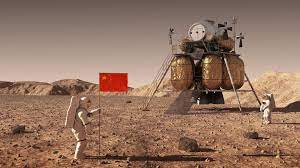Chinese space scientists have unveiled an ambitious roadmap that outlines their vision for a comprehensive space resource system spanning the solar system by the year 2100. China presents a bold space resource utilization vision. This initiative, named after the Ming dynasty scientist Song Yingxing’s work, “Tiangong Kaiwu,” or “The Exploitation of the Works of Nature,” holds the potential to revolutionize the global space economy and elevate China’s status in the world of space exploration.
The Visionary Leader
This project, under the direction of eminent scientist Wang Wei of the China Aerospace Science and Technology Corporation, primarily aims to explore, mine, and utilize water ice and mineral resources outside of Earth’s atmosphere. China presents bold space resource utilization vision. Wang Wei emphasized that the rapid advancement of space technologies has paved the way for the economic exploitation of space resources, extending beyond the Earth-moon system and becoming a significant player in global economic competition among nations.

The Blueprint for Space Resource Utilization
Wang Wei and his team have crafted an intricate plan that relies on strategically positioned gravitationally-balanced regions between celestial bodies as stepping stones to expand their reach. This plan was meticulously developed over three years and includes the establishment of facilities for extracting resources from the moon, near-Earth asteroids, Mars, main-belt asteroids, and the moons of Jupiter.
These strategically placed facilities will create a resupply system spanning the solar system, including gravitationally stable Lagrange points 1 and 2 between Earth and the moon, as well as points between the sun and Earth, Mars, and Jupiter. The plan also encompasses the construction of infrastructure such as resource transport routes and extraterrestrial mining and processing stations, facilitating large-scale, commercial space operations.
Technological Advancements Wang stressed that the success of their grand vision hinges on further advancements in technologies related to space resource mining and processing, flight-based transport, and cost-effective resource return.
More Space Exploration Initiatives
China’s commitment to space exploration extends beyond this roadmap. The nation actively pursues various missions aimed at advancing its capabilities in space resource utilization. These missions include launching the robotic probe Tianwen-2 in 2025 to collect samples from the near-Earth asteroid 2016 HO3, thereby exploring the feasibility of asteroid mining.
Another mission, the Chang’e-7 spacecraft, is set to land on the moon’s south pole in 2026 to search for water ice. This valuable resource can be purified for drinking water, converted into oxygen, and used as fuel, supporting extended astronaut stays on the lunar surface.
China has also revealed plans to send humans to the Moon for the first time by the end of this decade, reaffirming its commitment to space exploration. Several Chinese companies, such as the Nanjing-based start-up Origin Space, have joined the race to develop space mining technologies, underscoring China’s determination to establish a strong foothold in the evolving space resources industry.
Wang Wei and his team’s imaginative plan for using space resources paints a fascinating picture of the future of economic growth and space exploration in China. With their ambitious plans and commitment to technological advancement, China is poised to play a pivotal role in shaping the future of space resource utilization.
For further information: https://www.wsj.com/world/china/in-new-moon-race-russian-crash-shows-the-only-u-s-rival-is-china-422b3db2
Read our previous articles: https://scitechupdate.com/index.php/treated-wastewater-exerts-an-impact-on-our-rivers/ https://scitechupdate.com/index.php/india-makes-history-by-landing-a-spacecraft-at-the-moons-south-pole/
https://scitechupdate.com/index.php/zinc-air-batteries-could-be-cheaper-and-safer-than-lithium-ion/
Utilizing 239 Million-Year-Old Fossils to Enhance the Search for Martian Aliens
https://scitechupdate.com/index.php/android-14-satellite-sms-for-everyone/
https://scitechupdate.com/index.php/chemistry-entrepreneurship/
https://scitechupdate.com/index.php/waste-paper-to-battery-components-for-smarts-phones-vehicles/https://scitechupdate.com/index.php/ai-demonstrated-95-accuracy-in-listening-typing-and-data-processing/
https://scitechupdate.com/index.php/top-7-technology-trends-of-2023-from-ai-to-5d-technology/

Your point of view caught my eye and was very interesting. Thanks. I have a question for you.